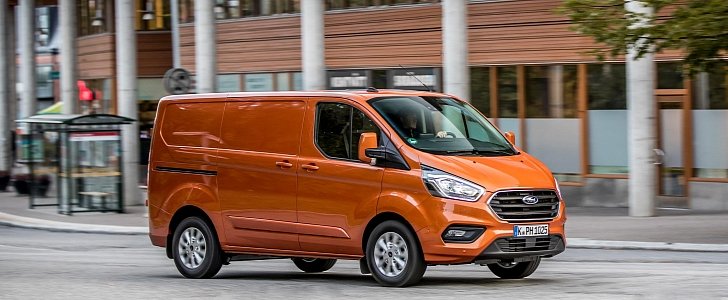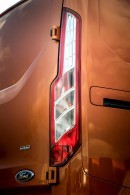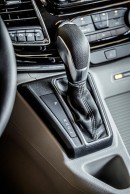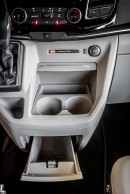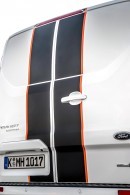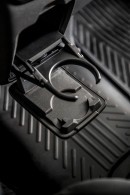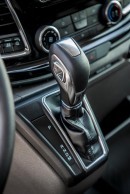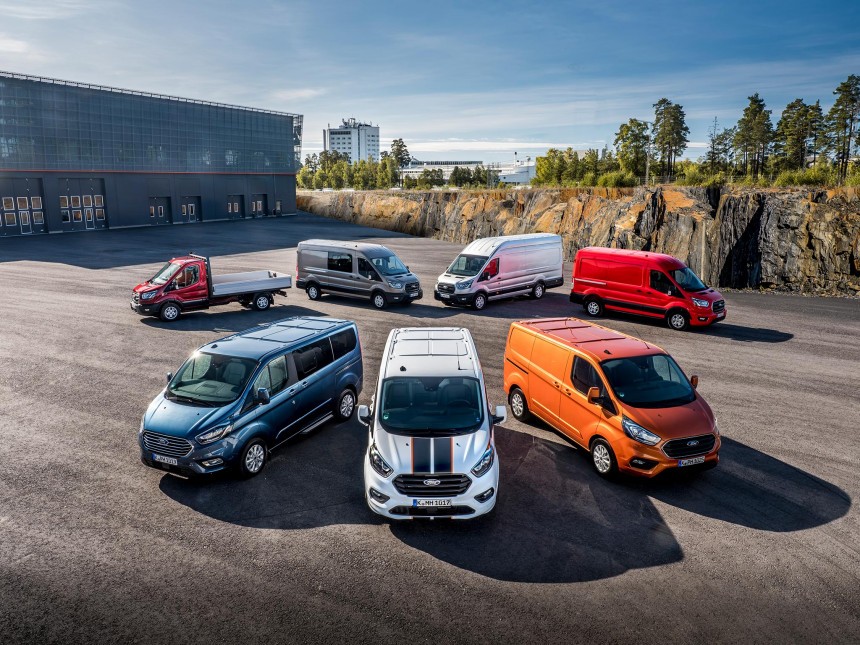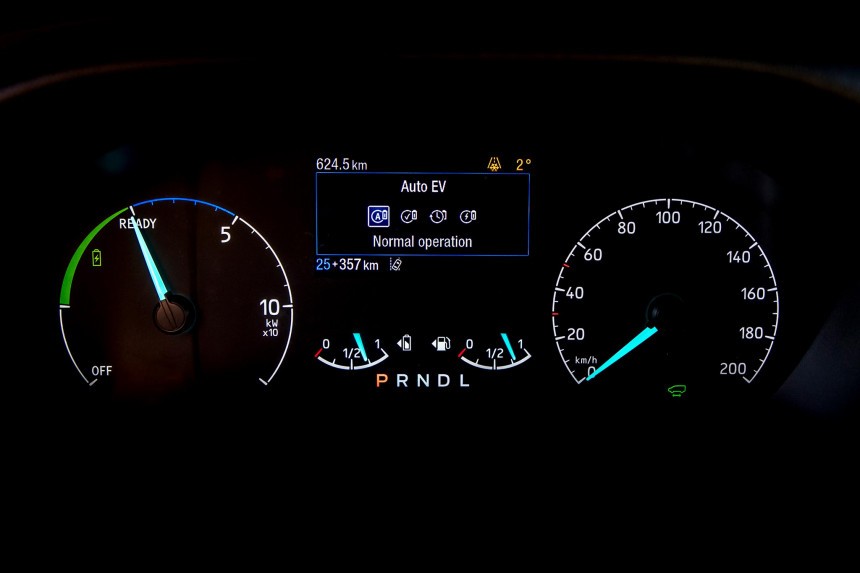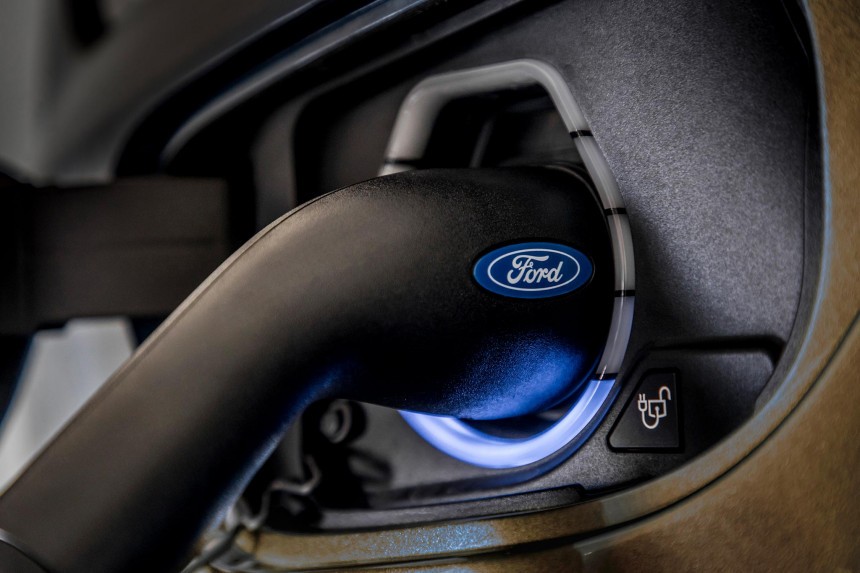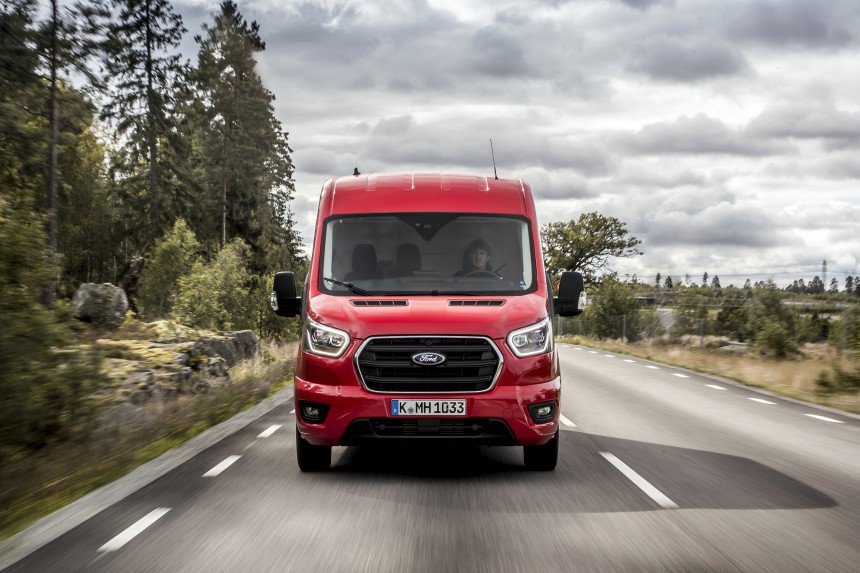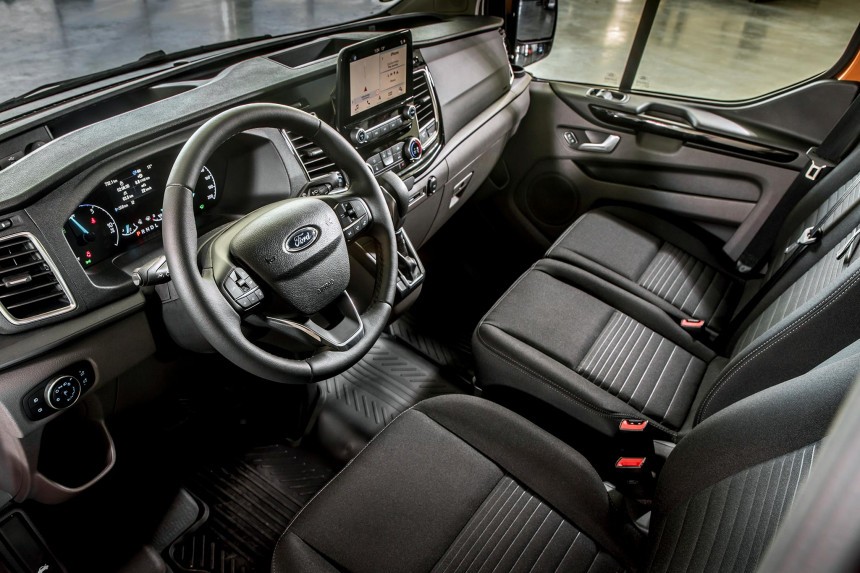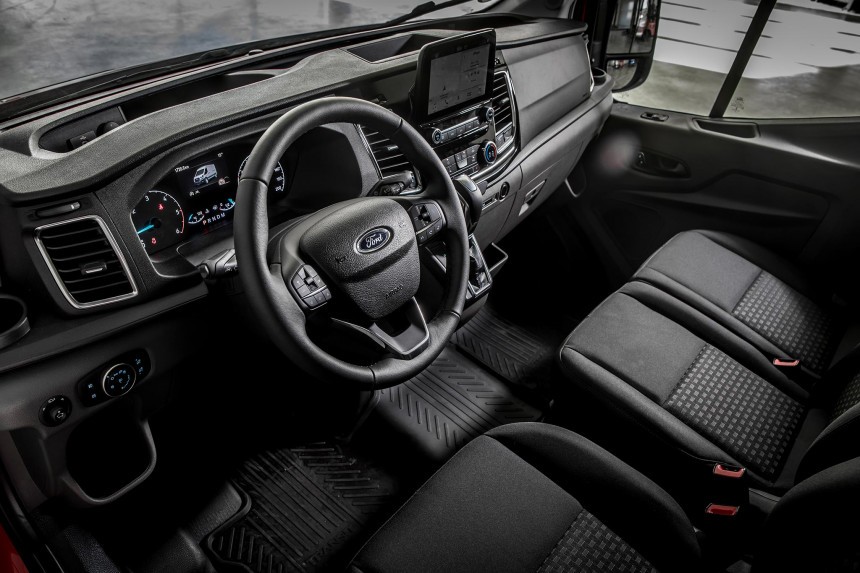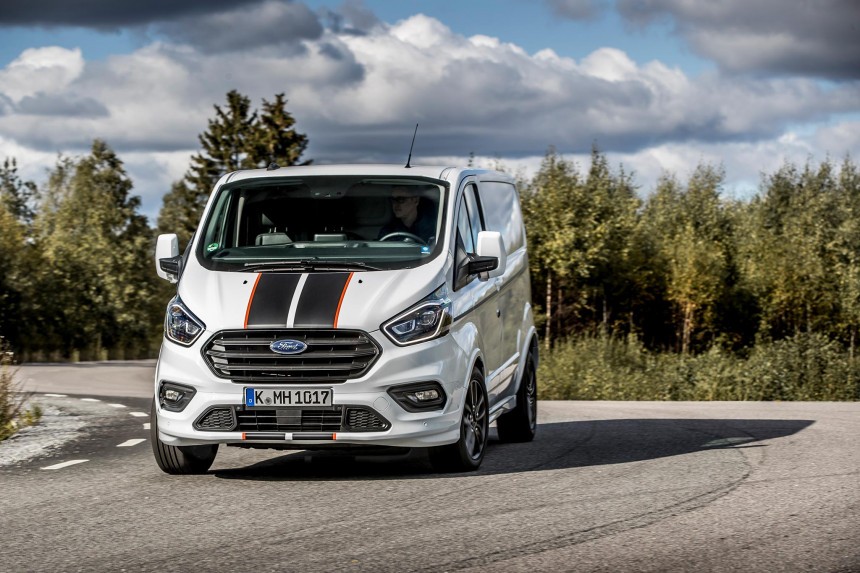Driven: 2019 Ford Transit/Turneo Custom Plug-In Hybrid (PHEV)
The 2019 Ford Transit Custom PHEV is a bit like the Porsche 911 and the BMW i3 Rex. No, really, it is: just like the Bavarian, this is actually an EV with a range extender, which means the three-cylinder turbo never sends power to the wheels, only being used as a generator that provides electric power.
And since the PHEV is part of the uber-comprehensive 2019 facelift covering the entire Transit family, we can talk about an extremely diverse line-up outside the pair of gas-electric models - as is the case with the 911, you can choose between an endless variety of derivatives, with the new Transit actually offering 450 configurations, depending on the number of seats, length, height, engine, gearbox and the driven wheels.
Of course, the similarities above are probably what an imaginary racing driver sees. As for how the practical driver defines the Transit Custom PHEV, this is simply the first plug-in hybrid van in the world.
And while Ford offers the electric setup for both the Transit Custom panel van and the Turneo Custom passenger version, these are only sold in Europe.
As for the US, only the larger Transit models are offered on this market, albeit with a high chance of the all-electric Transit, which is coming in 2021, to join the lineup on both sides of the pond.
The ways of the commercial vehicle world mean Ford has only introduced four Transit generations since 1965 original. And, for 2019, the carmaker has come up with the second extensive facelift - this one is pretty big and it's focused on powertrains, interior and safety technology, as well as on the exterior, in this order.
The changes from the 2019 European models and the 2020MY US market vehicles are different and I've recently spent a day with the revised Euro-spec Transit family.
While the electron juice sipper was the obvious focus, I also got behind the wheel of the big Transit, with the latter having also been touched by electrification, albeit to a lesser extent (think: 48V mild-hybrid energy recuperation and drive assistance).
The test vehicles had a 500-kilo (1,100 lbs) setup placed in their cargo areas, which, for the Custom models, meant 50 percent of the payload.
For the electric duo, we're looking at a 92.9 kW (126 hp) and 355 Nm (262 lb-ft) motor working with the usual single-speed gearbox.
The unit draws its energy from a 13.6 kWh battery pack, which can be charged by the 1.0-liter EcoBoost three-cylinder engine that's not linked to the driven front wheels and, of course, via the plug. And yes, if it amuses you, it's okay to mention this is the same engine that provides power for the Formula Ford EcoBoost single-seater.
So, once the 50 km (30+ miles) of tested electric driving range is out, you can rely on that range extender for an overall number that's ten times as large.
Yes, the size of the electric hardware does limit its use, but a larger system would've eaten into the payload, while this PHEV offers the same 1,130 kg as a diesel, even though there are versions of the latter that take the figure even higher.
The hybrid is only offered in the L1H1 (basic length and height versions) trim and since the batteries are tucked underneath the floor, the 5.0-liter cubic meter load capacity is unaffected. Of course, the Turneo Custom passenger models' usability is also unaffected by the electrification.
The carmaker talks about the benefits that the electric setup brings to the business owner .Nevertheless, I also wanted to find out how the electrification feels for the one who actually drives the vehicle (yes, there are obviously cases when the two roles overlap).
As such, I grabbed all the paper coffee cups I could find in the briefing room and set up a little slalom course in a parking lot found along the testing route.
I proceeded to run the course in the Transit Custom PHEV, as well as in a diesel (think: also-FWD, 185 hp, six-speed manual).
You'll get to zoom in on both runs below, but bear in mind that this was not a timed challenge, hence the various differences you'll get to see in the videos portraying the runs.
Instead, the idea was to see how the two derivatives felt in an environment involving the kind of tight space maneuvering and parking challenges of a crowded city.
Not to my surprise, the PHEV was easier to handle, keeping me relaxed behind the wheel, despite having the fate of so many cups in my hand -only one was harmed in the making of this video. Not only does this powertrain allow the driver to skip the gearshift, but its single-speed approach makes thins simpler.
However, this driving effort comparison ended with a difference that wasn't as large as I had imagined.
You see, the PHEV still required careful throttle modulation at low speeds, since the instant electric torque can try to overpower the front wheels. As for the manual diesel, well, any van driver should have a certain degree of experience, which means the clutch game becomes a bit of a reflex and doesn't take up that much attention.
Sure, my diesel tester had stripes on it, but there's no easy way to tell if you're approaching such a model or a PHEV. That's because the latter is only distinguished by its rear badge, the front bumper charging port flap or the humming of its 1.0-liter EcoBoost three-cylinder engine, which, by the way, goes through a wide rev range.
There are multiple EV-specific driving modes to choose from and we'll go through them below.
EV Auto: This is the default mode, which means that situations involving high energy consumption, such as climbing a hill or overtaking, are going to see the gas engine kicking in to keep that battery charge at a reasonable level.
However, instead of using the navigation to determine when the said scenarios would arrive, as is the case with the latest plug-in hybrid vehicles, the system seemed to deplete the battery first and then ask for the gas engine to step in and charge it.
EV Now: This ensures that, as long as there's a certain amount of battery charge, the van will only use electric power. And while this mode can be engaged manually for crowded urban areas, Ford will introduce a geofencing system that will automatically call for this function in certain areas (more on this below).
EV Later: The gas engine is turned on, with the aim of maintaining the battery charge available at a given time - this is something you want to do when approaching a zero emissions zone, for instance.
EV Charge: In this mode, the 1L EcoBoost doesn't just act as a generator providing power to the electric motor, but also tops up the battery.
"What's up with that "L" position of the gear shifter?" I hear you asking? Well, regardless of the driving mode, you can switch from Drive into this to trigger a more aggressive setup for the regenerative braking. Basically, going into "L" means you'll be able to perform the one-pedal driving so many modern EVs have accustomed us with. And since this mode is more energy-efficient and gives you a little deceleration game to play in heavy traffic, you'll probably want to use it in such scenarios.
The electrification doesn't change the handling or the ride quality of the Transit Custom, so you can enter bends with confidence and you'll have no trouble getting over bumps, at least in the half-load testing configuration (unloaded vans are known for their slightly bumpy ride when unloaded, but I didn't get to test this).
In fact, the only quirk of the electric model is that, when the 1L EcoBoost is asked to do its job, the revs are obviously not matched to your acceleration, as it would happen with a CVT, but you can easily get accustomed to this.
And since Ford used Turneo Custom PHEVs to transport us between the airport and the driving location (by the way, the testing took place in Sweden), I also got the passenger experience - the electric drive only adds to the refinement, while a normal stereo volume means the gas engine waking up to life won't bother you.
Clearly, the most efficient way to use a Ford Transit Custom is to reach for the plug when possible rather than rely on the gas engine to replenish the battery charge. A standard plug means you'll spend 4.3 hours for a full charge, but a dedicated charging station will cut that time to 2.7 hours.
We have to keep in mind that the small gas engine is there to deal with range anxiety, so its average efficiency, which sat at 7.5 l/100 km (31.3 US mpg) for my drive, won't be all that great. So the idea is to charge the vehicle overnight.
As such, I decided to go all WRC on the big van, as illustrated in the clip below.
Sure, the 2019 Ford Transit is no Fiesta WRC car, even though I've been inside both this fall. But rather than my rallying adventure being the reason behind the said video, there's another conclusion that led to this clip being put together - The partially common architecture of the Transit and the Transit Custom means the larger model is remarkably close to the fluent driving experience of its smaller brother.
For instance, in the dry testing conditions, there wasn't a single moment when the RWD layout of the big van disturbed the peaceful experience, despite me exploring the limits of the chassis at times. Even when pushed hard on a dirt road, the chassis setup and the electronics means the progressive understeer safety net does its job well, so you can haul all you want.
In fact, the new driving modes feature means that while FWD models offer Normal and Eco setups, AWD and RWD configurations get extra modes for when the road is slippery.
Speaking of those weight savings, these obviously translate into payload boosts, with net payloads now climbing up to 1,418 kg for the 3.5 ton models. The van clientele loves such numbers, so they should know that the towing capability of the two range-topping diesels has increased to 3.5 tons.
And we haven't even reached the part regarding the torque curve improvement: the 2019 Ford Transit, which features the first 48V mild-hybrid setup in its segment.
As the engineers explained during the presentation before the drive, the aim wasn't to offer extra electric torque on top of what the two-liter diesel supplies, but rather to ensure the electric motor assists the combustion engine down in the rpm range, when the turbo is busy spooling (this didn't keep the turbo from being redesigned towards delivering a smoother torque curve, though).
The two-liter turbodiesel has also been updated, receiving goodies like optimized steel pistons that reduce internal friction compared to the previous aluminum design (think: slimmer skirts), increased peak injection pressure and a variable-flow oil pump.
And, to return to those driving-hard conclusions, the existing 105 hp, 130 and 170 hp versions of the diesel have been joined by an 185 hp version, which also delivers 415 Nm/306 lb-ft of torque.
From behind the wheel, you do feel the more linear power delivery, while there was no time to put the claimed 3-8 percent fuel efficiency boost of the 48V system to the test.
Admittedly, I haven't sampled the entry-level output, but even the 130 hp model is enough to carry the load while keeping the driver stress-free, highway speeds included.
Alas, I could only drive the six-speed automatic offered on the FWD setup, which feels decent, but nothing more. Then again, starting next spring, the RWD models will be offered with Ford's ten-speed auto, which I've made friends with while driving the latest Mustang GT update.
All the models in the family, from the Turneo Custom to the Transit, come with a modern, cozy interior, since the cabin of the larger van has been overhauled to match the revised interior of the smaller models. And given the aging interior of the old models, this transformation couldn't come soon enough. Fortunately, Ford has put a lot of effort into updating the cabin and you can feel this once stepping inside the vehicles.
As you'd expect from such machines, there are plenty of practicality treats. For instance, you smartphone will easily fit into the side cupholder of the Transit, where you can even use navigation apps like Waze.
The only gripes I've had involve the upright backrest of the passenger seats in the front rows, which isn't adjustable for any of the models, as well as the position of the gear selector display of the Custom PHEVs - this sits in the lower side of the instrument cluster and, for instance, if you're turning the wheel while going from Drive into Neutral or Reverse, you can't instantly see which gear you've actually engaged.
The entire lineup packs a 4G on-board modem. Ford offers a dedicated telematics app for fleets of up to 5 vehicles, while also offering a solution for larger vehicle pools - you can work with the Ford app or send the data to a third-party app of your choice.
Of course, the PHEV duo makes use of this feature for its geofencing strategy. So the vehicle can be programmed to automatically engage EV mode when entering a zero emissions area like the one in London. However, you can also play Major and set up such a zone around your house.
Now that the big Transit has also been fitted with electrically-assisted steering (this really comes in handy when parking, since it's nice and light), the entire Transit range can be offered with a host of active safety technologies: blind spot warning (trailer included), adaptive cruise control, lane-keeping assist, active park assist and pre-collision assist with pedestrian detection, as well as cross traffic alert. Oh, and thanks to front and rear wide-angle cameras, visibility in uber-tight scenarios is no longer an issue.
While we're talking optional extras, I'll also mention the power side load door of the Transit (coming next spring), as well as its LED downlighter, which illuminates the working area behind the vehicle.
And while the test cars still moved about a bit after the Park position of the transmission was engaged, there were no other signs of the system's young age, which means the said ironing has been done well.
Both the all-electric driving range and the gearing of the single-speed transmission (which caps acceleration past 100 kph/62 mph), turn the Transit/Turneo Custom PHEV into an urban dweller. And while it can sustain trips outside the city, there's no point in deploying such a carrier on the highway.
High speeds are where the powerful diesels come into play - in fact, a spirited drive in the new 185 hp Transit Custom Sport made for a memorable experience. Even with half a ton of sand in the back, the van was pleasant to throw around corners at surprising speeds.
So that M-Sport kit for the van (this is Ford's WRC partner, remember?), which makes for the MS-RT Transit Custom, might just be a good idea, even though the latest facelift doesn't seem to get the custom suspension its predecessors received. Heck, there are even tuners who will attempt to make your Transit Custom look like the Focus RS.
Nevertheless, let's get back to the EV, shall we?
The warranty for the battery sits at 8 years or 160,000 km/100,000 miles. After that point, you'll be left with 70% of the battery capacity. And, judging by the discussions I've had with company managers who were on site, it looks like the automaker is preparing a financial plan that takes this into account, albeit with no further details delivered.
While we're talking costs, let's take a bit of time to zoom in on the pricing. Each country has its specific electrification strategy and we'll focus on the UK.
You'll have to pay at least £39,145 (plus VAT) for the base trim level of the Transit Custom PHEV, which is almost a £15,000 premium compared to a similar diesel. However, the government's plug-in van grant means you can slice 20 percent of that price (but no more than £8,000)
Then there are the cost savings brought by electricity, which are considerable compared to running on diesel, especially since such vehicles tend to have a high annual mileage.
The Ford Transit/Turneo Custom PHEV is the first plug-in hybrid van and choosing this over the diesel will cater to the needs of those who mostly cover urban areas, while having to deal with zero-emission areas.
However, the few all-electric vans on the market will be joined by a much larger variety across multiple segments next decade and while the lack of a range extender means you'll have to do careful planning and carry a slightly smaller load (vs similar diesel modes), full EVs will obviously be even more efficient than hybrids.
The heavily revised 2019 Ford Transit range brings tons of changes. And since we've already covered the range-extended EV, you should know that the diesels are now slightly more efficient and even easier to drive than before.
It wasn't too long ago when van drivers had to rely mostly on their experience to get that cargo to its destination safely. However, models like the 2019 Ford Transit family make life much easier for the one behind the wheel, from the added safety and power improvements, to the surprisingly car-like driving experience.
Of course, the similarities above are probably what an imaginary racing driver sees. As for how the practical driver defines the Transit Custom PHEV, this is simply the first plug-in hybrid van in the world.
And while Ford offers the electric setup for both the Transit Custom panel van and the Turneo Custom passenger version, these are only sold in Europe.
As for the US, only the larger Transit models are offered on this market, albeit with a high chance of the all-electric Transit, which is coming in 2021, to join the lineup on both sides of the pond.
The ways of the commercial vehicle world mean Ford has only introduced four Transit generations since 1965 original. And, for 2019, the carmaker has come up with the second extensive facelift - this one is pretty big and it's focused on powertrains, interior and safety technology, as well as on the exterior, in this order.
The changes from the 2019 European models and the 2020MY US market vehicles are different and I've recently spent a day with the revised Euro-spec Transit family.
The test vehicles had a 500-kilo (1,100 lbs) setup placed in their cargo areas, which, for the Custom models, meant 50 percent of the payload.
For the electric duo, we're looking at a 92.9 kW (126 hp) and 355 Nm (262 lb-ft) motor working with the usual single-speed gearbox.
The unit draws its energy from a 13.6 kWh battery pack, which can be charged by the 1.0-liter EcoBoost three-cylinder engine that's not linked to the driven front wheels and, of course, via the plug. And yes, if it amuses you, it's okay to mention this is the same engine that provides power for the Formula Ford EcoBoost single-seater.
So, once the 50 km (30+ miles) of tested electric driving range is out, you can rely on that range extender for an overall number that's ten times as large.
Yes, the size of the electric hardware does limit its use, but a larger system would've eaten into the payload, while this PHEV offers the same 1,130 kg as a diesel, even though there are versions of the latter that take the figure even higher.
The hybrid is only offered in the L1H1 (basic length and height versions) trim and since the batteries are tucked underneath the floor, the 5.0-liter cubic meter load capacity is unaffected. Of course, the Turneo Custom passenger models' usability is also unaffected by the electrification.
The carmaker talks about the benefits that the electric setup brings to the business owner .Nevertheless, I also wanted to find out how the electrification feels for the one who actually drives the vehicle (yes, there are obviously cases when the two roles overlap).
As such, I grabbed all the paper coffee cups I could find in the briefing room and set up a little slalom course in a parking lot found along the testing route.
I proceeded to run the course in the Transit Custom PHEV, as well as in a diesel (think: also-FWD, 185 hp, six-speed manual).
You'll get to zoom in on both runs below, but bear in mind that this was not a timed challenge, hence the various differences you'll get to see in the videos portraying the runs.
Instead, the idea was to see how the two derivatives felt in an environment involving the kind of tight space maneuvering and parking challenges of a crowded city.
Not to my surprise, the PHEV was easier to handle, keeping me relaxed behind the wheel, despite having the fate of so many cups in my hand -only one was harmed in the making of this video. Not only does this powertrain allow the driver to skip the gearshift, but its single-speed approach makes thins simpler.
However, this driving effort comparison ended with a difference that wasn't as large as I had imagined.
You see, the PHEV still required careful throttle modulation at low speeds, since the instant electric torque can try to overpower the front wheels. As for the manual diesel, well, any van driver should have a certain degree of experience, which means the clutch game becomes a bit of a reflex and doesn't take up that much attention.
Sure, my diesel tester had stripes on it, but there's no easy way to tell if you're approaching such a model or a PHEV. That's because the latter is only distinguished by its rear badge, the front bumper charging port flap or the humming of its 1.0-liter EcoBoost three-cylinder engine, which, by the way, goes through a wide rev range.
There are multiple EV-specific driving modes to choose from and we'll go through them below.
EV Auto: This is the default mode, which means that situations involving high energy consumption, such as climbing a hill or overtaking, are going to see the gas engine kicking in to keep that battery charge at a reasonable level.
However, instead of using the navigation to determine when the said scenarios would arrive, as is the case with the latest plug-in hybrid vehicles, the system seemed to deplete the battery first and then ask for the gas engine to step in and charge it.
EV Now: This ensures that, as long as there's a certain amount of battery charge, the van will only use electric power. And while this mode can be engaged manually for crowded urban areas, Ford will introduce a geofencing system that will automatically call for this function in certain areas (more on this below).
EV Later: The gas engine is turned on, with the aim of maintaining the battery charge available at a given time - this is something you want to do when approaching a zero emissions zone, for instance.
EV Charge: In this mode, the 1L EcoBoost doesn't just act as a generator providing power to the electric motor, but also tops up the battery.
"What's up with that "L" position of the gear shifter?" I hear you asking? Well, regardless of the driving mode, you can switch from Drive into this to trigger a more aggressive setup for the regenerative braking. Basically, going into "L" means you'll be able to perform the one-pedal driving so many modern EVs have accustomed us with. And since this mode is more energy-efficient and gives you a little deceleration game to play in heavy traffic, you'll probably want to use it in such scenarios.
In fact, the only quirk of the electric model is that, when the 1L EcoBoost is asked to do its job, the revs are obviously not matched to your acceleration, as it would happen with a CVT, but you can easily get accustomed to this.
And since Ford used Turneo Custom PHEVs to transport us between the airport and the driving location (by the way, the testing took place in Sweden), I also got the passenger experience - the electric drive only adds to the refinement, while a normal stereo volume means the gas engine waking up to life won't bother you.
Clearly, the most efficient way to use a Ford Transit Custom is to reach for the plug when possible rather than rely on the gas engine to replenish the battery charge. A standard plug means you'll spend 4.3 hours for a full charge, but a dedicated charging station will cut that time to 2.7 hours.
We have to keep in mind that the small gas engine is there to deal with range anxiety, so its average efficiency, which sat at 7.5 l/100 km (31.3 US mpg) for my drive, won't be all that great. So the idea is to charge the vehicle overnight.
What about the Transit?
Well, it seems like the Blue Oval has turned this big boy into some sort of rally car - the company mentions weight reduction thanks to an aluminum hood, lighter steel wheels, a re-engineered rear axle and a redesigned exhaust system, among others. So while the FWD models are up to 48 kg lighter, the RWD models have shed up to 80 kg.As such, I decided to go all WRC on the big van, as illustrated in the clip below.
Sure, the 2019 Ford Transit is no Fiesta WRC car, even though I've been inside both this fall. But rather than my rallying adventure being the reason behind the said video, there's another conclusion that led to this clip being put together - The partially common architecture of the Transit and the Transit Custom means the larger model is remarkably close to the fluent driving experience of its smaller brother.
For instance, in the dry testing conditions, there wasn't a single moment when the RWD layout of the big van disturbed the peaceful experience, despite me exploring the limits of the chassis at times. Even when pushed hard on a dirt road, the chassis setup and the electronics means the progressive understeer safety net does its job well, so you can haul all you want.
In fact, the new driving modes feature means that while FWD models offer Normal and Eco setups, AWD and RWD configurations get extra modes for when the road is slippery.
Speaking of those weight savings, these obviously translate into payload boosts, with net payloads now climbing up to 1,418 kg for the 3.5 ton models. The van clientele loves such numbers, so they should know that the towing capability of the two range-topping diesels has increased to 3.5 tons.
As the engineers explained during the presentation before the drive, the aim wasn't to offer extra electric torque on top of what the two-liter diesel supplies, but rather to ensure the electric motor assists the combustion engine down in the rpm range, when the turbo is busy spooling (this didn't keep the turbo from being redesigned towards delivering a smoother torque curve, though).
The two-liter turbodiesel has also been updated, receiving goodies like optimized steel pistons that reduce internal friction compared to the previous aluminum design (think: slimmer skirts), increased peak injection pressure and a variable-flow oil pump.
And, to return to those driving-hard conclusions, the existing 105 hp, 130 and 170 hp versions of the diesel have been joined by an 185 hp version, which also delivers 415 Nm/306 lb-ft of torque.
From behind the wheel, you do feel the more linear power delivery, while there was no time to put the claimed 3-8 percent fuel efficiency boost of the 48V system to the test.
Admittedly, I haven't sampled the entry-level output, but even the 130 hp model is enough to carry the load while keeping the driver stress-free, highway speeds included.
Alas, I could only drive the six-speed automatic offered on the FWD setup, which feels decent, but nothing more. Then again, starting next spring, the RWD models will be offered with Ford's ten-speed auto, which I've made friends with while driving the latest Mustang GT update.
As you'd expect from such machines, there are plenty of practicality treats. For instance, you smartphone will easily fit into the side cupholder of the Transit, where you can even use navigation apps like Waze.
The only gripes I've had involve the upright backrest of the passenger seats in the front rows, which isn't adjustable for any of the models, as well as the position of the gear selector display of the Custom PHEVs - this sits in the lower side of the instrument cluster and, for instance, if you're turning the wheel while going from Drive into Neutral or Reverse, you can't instantly see which gear you've actually engaged.
The entire lineup packs a 4G on-board modem. Ford offers a dedicated telematics app for fleets of up to 5 vehicles, while also offering a solution for larger vehicle pools - you can work with the Ford app or send the data to a third-party app of your choice.
Of course, the PHEV duo makes use of this feature for its geofencing strategy. So the vehicle can be programmed to automatically engage EV mode when entering a zero emissions area like the one in London. However, you can also play Major and set up such a zone around your house.
Now that the big Transit has also been fitted with electrically-assisted steering (this really comes in handy when parking, since it's nice and light), the entire Transit range can be offered with a host of active safety technologies: blind spot warning (trailer included), adaptive cruise control, lane-keeping assist, active park assist and pre-collision assist with pedestrian detection, as well as cross traffic alert. Oh, and thanks to front and rear wide-angle cameras, visibility in uber-tight scenarios is no longer an issue.
While we're talking optional extras, I'll also mention the power side load door of the Transit (coming next spring), as well as its LED downlighter, which illuminates the working area behind the vehicle.
The Big Picture
Before setting the Transit Plug-In Hybrid free into the world, Ford completed a year-long trial in London. We're talking about a 20-van fleet spread across 16 businesses, with the combined mileage of these test vehicles, which were largely identical to the showroom model, sitting at 240,000 km (150,000 miles), of which 75 percent was completed in all-electric mode.And while the test cars still moved about a bit after the Park position of the transmission was engaged, there were no other signs of the system's young age, which means the said ironing has been done well.
Both the all-electric driving range and the gearing of the single-speed transmission (which caps acceleration past 100 kph/62 mph), turn the Transit/Turneo Custom PHEV into an urban dweller. And while it can sustain trips outside the city, there's no point in deploying such a carrier on the highway.
High speeds are where the powerful diesels come into play - in fact, a spirited drive in the new 185 hp Transit Custom Sport made for a memorable experience. Even with half a ton of sand in the back, the van was pleasant to throw around corners at surprising speeds.
So that M-Sport kit for the van (this is Ford's WRC partner, remember?), which makes for the MS-RT Transit Custom, might just be a good idea, even though the latest facelift doesn't seem to get the custom suspension its predecessors received. Heck, there are even tuners who will attempt to make your Transit Custom look like the Focus RS.
Nevertheless, let's get back to the EV, shall we?
The warranty for the battery sits at 8 years or 160,000 km/100,000 miles. After that point, you'll be left with 70% of the battery capacity. And, judging by the discussions I've had with company managers who were on site, it looks like the automaker is preparing a financial plan that takes this into account, albeit with no further details delivered.
While we're talking costs, let's take a bit of time to zoom in on the pricing. Each country has its specific electrification strategy and we'll focus on the UK.
You'll have to pay at least £39,145 (plus VAT) for the base trim level of the Transit Custom PHEV, which is almost a £15,000 premium compared to a similar diesel. However, the government's plug-in van grant means you can slice 20 percent of that price (but no more than £8,000)
Then there are the cost savings brought by electricity, which are considerable compared to running on diesel, especially since such vehicles tend to have a high annual mileage.
The Ford Transit/Turneo Custom PHEV is the first plug-in hybrid van and choosing this over the diesel will cater to the needs of those who mostly cover urban areas, while having to deal with zero-emission areas.
However, the few all-electric vans on the market will be joined by a much larger variety across multiple segments next decade and while the lack of a range extender means you'll have to do careful planning and carry a slightly smaller load (vs similar diesel modes), full EVs will obviously be even more efficient than hybrids.
The heavily revised 2019 Ford Transit range brings tons of changes. And since we've already covered the range-extended EV, you should know that the diesels are now slightly more efficient and even easier to drive than before.
It wasn't too long ago when van drivers had to rely mostly on their experience to get that cargo to its destination safely. However, models like the 2019 Ford Transit family make life much easier for the one behind the wheel, from the added safety and power improvements, to the surprisingly car-like driving experience.
ford transit Ford Transit Custom Ford Transit Custom Plug-In Hybrid Ford Transit Custom PHEV Driven ford turneo custom phev
About the author: Andrei Tutu

In his quest to bring you the most impressive automotive creations, Andrei relies on learning as a superpower. There's quite a bit of room in the garage that is this aficionado's heart, so factory-condition classics and widebody contraptions with turbos poking through the hood can peacefully coexist.
Full profile
